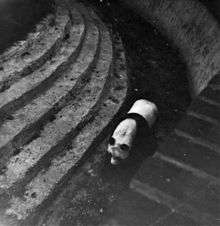Chi Chi (giant panda)

Chi Chi (Chinese: 姬姬; pinyin: Jī Jī; September 1954 in wild in Sichuan, China – 22 July 1972 London Zoo, United Kingdom) was a well-known female giant panda at London Zoo in England.[1]
Chi Chi was not London Zoo's first giant panda; Ming was one of four that arrived in 1938. However, it was Chi Chi who became the Zoo's star attraction and Britain's best-loved zoo animal.[2]
Life
She was caught in May 1955 in Baoxing, Sichuan, and moved to the Beijing Zoo in June. In May 1957, Kliment Voroshilov made a request for panda for Moscow Zoo during his visit to China, then she was sent to Moscow with another panda in the same month. However, the attempts to mate them were unsuccessful. Russian suspected that both pandas were male, and as a result, Soviet returned Chi Chi to China in exchange for another panda in January 1958.[2][3] In May of the same year, the Austrian animal broker, Heini Demmer, acquired Chi Chi from Beijing Zoo in exchange for an impressive collection of African hoofstock and brought the animal back to Moscow Zoo. After resting for a week, the panda journeyed to Tierpark Berlin, the zoo in East Berlin. By then, Chi Chi had already been sold to Brookfield Zoo in Illinois, United States. However, the Treasury Department stepped in and announced that the US trade embargo on goods from the People's Republic of China extended even to pandas.[4] Chi Chi was thus refused entry to the USA. The Frankfurt Zoological Garden provided a temporary home for the panda until Demmer decided to temporarily hire the animal out to European zoos. She then visited Copenhagen Zoo before she arrived at London Zoo on 5 September 1958. The Zoological Society of London had stated that it would not encourage collection of wild pandas, but accepted Chi Chi since she had already been collected. Although Chi Chi's visit was originally planned to last for only three weeks, it was decided to buy her for £12,000. Chi Chi became property of London Zoo on 26 September 1958.[5]
Chi Chi was an inspiration for Sir Peter Scott's simple but distinctive black and white design used as the logo of the World Wildlife Fund.[6][7] However the organization's current logo is not the logo designed by Peter Scott but a later one, designed for WWF in 1986 when it changed its name from World Wildlife Fund to World Wide Fund for Nature.

Chi Chi died on 22 July 1972[8] and was mourned by the nation.[2] A post mortem was conducted. Her remains, now a stuffed exhibit, sit in a glass case, at London's Natural History Museum.[9]
See also
- Other notable animals at London Zoo
- Panda diplomacy
- Tián Tián, giant panda at Edinburgh Zoo
References
- ↑ Michael R. Brambell, London Zoo's Giant panda: Ailuropoda melatiolenca: 'Chi Chi', 1957–1972. International Zoo Yearbook, Volume 14, Issue 1, pages 163–164. Published online 18 December 2007. The Zoological Society of London, 1985. doi:10.1111/j.1748-1090.1974.tb00809.x.
- 1 2 3 "London Zoo". Good Zoos. Retrieved 2008-03-05. External link in
|publisher=(help) - ↑ "姬姬". Baidu Baike. Retrieved 11 February 2016.
- ↑ Chinoy, Michael (1975). "Pandamonium, or Everything You Always Wanted to Know About Pandas" (PDF). New China. 1 (1): 16. Retrieved 18 November 2015.
- ↑ Ramona Morris & Desmond Morris: The Giant Panda. Revised edition by Jonathan Barzdo. Papermac, London 1981, pp. 93-111, ISBN 0-333-32473-0
- ↑ Strategic management for voluntary nonprofit organizations. Routledge. Retrieved 2008-10-28.
- ↑ WWF: Giant Panda
- ↑ Gwynne Vevers: London's Zoo. London 1976, p. 99, ISBN 0-370-10440-4
- ↑ Henry Nicholls (2011). The Way of the Panda: The Curious History of China's Political Animal. Open Road Media. ISBN 978-1-4532-1773-3.
Further reading
Heini Demmer, Ute Demmer & Erich Tylinek: Tschitschi der Bambusbär. Artia, Prague 1961.